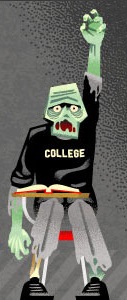
Question #1: Can a zombie hold a #2 pencil?
Question #2: How many adults does it take to annihilate a generation of creative thinkers and turn public schooling into a chessboard of teen zombies in a twisted game of corporate profit?
One member of the GATE team opines, “You know, kindergarten used to get it right. Early education used to truly champion creative thinking, but oh no. No nostalgic bastion of Play-Doh and Crayola now… as territory for computer stations and testing is conceded to the enemy at alarmingly younger ages. ‘Now, Jack, can you point to the wisdom of life residing hidden somewhere between answers A and E on this scantron?’ No, Jack wants to run across a playground and assess how the wind’s velocity moves his kite. He wants to write a poem to the breeze, but no time for that. Give him an electronic pacifier and sit him down with the other automaton. After all, think of all the money that will flow to testing agencies and gadget builders.”
This blog is about cognitive independence, something the faculty at GATE cares about passionately. We do not want to see the marketization of education trickling down to result in reduced student engagement a la Dawn of the Ever-Loving Dead.
Most parents remember fondly art projects coming home by the arms-full—magazine images torn and carefully glued to honor various themes of the week as kids grow up. What’s important about all collage work? In essence, those types of projects provide the framework for what needs to come later in terms of inspired thinking. What does ripping up little bits of paper have to do with teaching teens to be cognitively independent as they approached their college years?
Just as collage is the art of overlapping images from seemingly disparate sources, brilliant teen thinkers learn to collate, compare and contrast material from inside, outside, and nowhere near “the box.” They do what a favorite verb of all time describes (yes, oftentimes we geeky teacher types actually have favorite verbs, and this is one of GATE’s). They juxtapose.
When students recognize the fact that they are not merely being asked to “fill a bucket” of facts, they come alive. We’ve seen it again and again. Some teens just “get it” –their body language in the classroom, interactions with their teacher, and written responses all reflect personal investment. In order for teens to build this fire inside themselves, though, parents and mentors need to stoke the embers. Sadly, students nowadays are less and less likely to be led to inspiring school work and personal growth.
Many students across America lack mentors, and that’s where GATE comes in. Our video-centered approach to helping students allows them to identify the step by step process they need to travel in order to secure their post-graduation success.
Why do so many people today see creativity and critical thinking as diametrically opposed? Don’t adults all realize the inherent creative urge hidden within every new scientific theory, piece of dance choreography, new breakdown of a mathematical equation, or literary analysis of newly published nonfiction? A student can be creative in anything. That is, unless the entire urge to create has been systematically removed in a race to nowhere. The human factor cannot be left behind without losing a generation of students.
Human faces humanly (humanely!) mentoring students is the only way to personalize an approach to something as sensitive as determining one’s course for the future. Imagine being an economically disadvantaged, first generation student—wouldn’t you rather have video access to experts in a proven process helping you than widgets, charts and graphs?
Educators today long to encourage kids to innovate and to explore, but wrong-headed initiatives to cash-strapped administrators hogtie the better angels among us, and students are the ones who suffer as fewer and fewer truly inspiring educators can access them. Ed-tech solutions like GATE can fill the gap with digital access to top experts available to any student, anywhere. Budget-conscious schools and districts can leverage affordable help to reach many more students than they can otherwise afford.
As much as students need structure and inarguable facts, they need to experiment and find their voices, not asphyxiate within finite rosters of supposed “answers” to prescribed subsets of curricula. Real teachers, the kind you loved when you were in high school, know this. Sure, in math class 2 plus 2 will always equal 4; however, within many areas of study, championing innovation is not only better for students, it’s better suited to the real-world applications needed by large and small businesses across America who need creative thinkers, not just answer-givers.
Here’s to the crazy ones…
